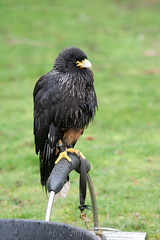Question by ravenclawdragon: What are common injuries to birds of Prey?
I would love to work with Animals, and I was wondering, what is are the common injuries to birds of prey also known as raptors.
Best answer:
Answer by nekospiritfire
It’s somewhat size dependent.
In order I’d say:
1.)Wing Injury
2.)Eye Injury
3.)Foot Injury
4.)Other
Secondary injury
1.) Parasite Damage
2.) Feather Damage (general)
3.) Pecking damage
More detailed..
In hawk and larger sized birds of prey, the most common injuries we see are wing injuries (often because grounded raptors draw quick attention and are possible to contain easier).
These tend to be caused by cars, which often fracture the radius and ulna, or cause tearing in the muscle and ligament near the corocoid, swelling alone from joint stress can ground birds even without a fracture. Powerline burns are not entirely uncommon. The other sources of wing injury are sourced from other impairment (disease/malnourishment/impairment) Some impact where they normally wouldn’t if they have eye injuries, we’ve also had raptors that have impaled themselves where weakness caused by parasatism hurts their ability to land correctly (and they fall into awkwardly angled branches).
If a wing has been broken for long enough for infection to set in (and the wing is dangling, hindering the bird) they will sometimes self-cannablize, biting the wing at the break until it detaches (freeing them of the dangling section and source of infection).
Eye injuries are not uncommon, minor wounds usually doesn’t hurt their ability to see so badly it cannot heal, but it depends where the scar tissue forms to determine if they will recover with full vision.
And while speaking of eye injuries, the most common injury we see in screech owls and raptors of similar size is a “blown out” eye. When these light birds get hit by cars they are often deflected, their weight often keeps it from being a lethal force, however the trauma to the head (anywhere) will often destroy many blood vessels in the eye, possibly vital areas, which causes anything from temporary or permanent blindness to the inability to dilate correctly.
Larger birds (namely owls, due to their large eyes and orbital housing) come in with eye injuries, but often the trauma kills them outright so we never do see them, or we get them but they show symptoms of brain or nerve damage and are usually injured in other areas as well.
Next would be damage to the toes and legs, these are often bite wounds caused by difficult prey (namely squirrels) usually there are minor cuts on the toes and major punctures and lacerations on the ankle and leg. These are usually already filled with maggots and are showing signs of infection by the time we get them, also, even minor expected cuts on the feet can result in debilitating infections if it is exposed at the wrong time to a weakened bird.
___________________________________________
Secondary injuries:
1.) Parasite damage: Maggots and Flat flies do damage quickly, maggots commonly found on birds secrete enzymes that begin killing living flesh once they are out of dead flesh and blood to feed on, exacerbating wounds. Flat flies both bite and lay eggs on their avian hosts when sick or injured.
2.) Pecking damage: Weakened raptors are often quickly mobbed by smaller avian meat eaters, or even defensive song birds. The usual culprits are crows, pecking damage on raptors is not as severe as it is on songbirds, usually softened by feathers enough to protect from impact fracturing and brain damage (so we usually just see feather damage as evidence) however often pecking around the eyes and beak causes wounds and swelling.
3.) Feather Damage: Being unable to fly or balance or land correctly will all end in feather damage. The most severe of which are either injuries caused by compensation for a broken wing or neurological balance problems, wherein the bird outstretches one wing to the ground for balance, each time stressing or breaking and tearing feathers.
What do you think? Answer below!
Tags:Birds, common, injuries, Prey





0 comments:
Post a Comment